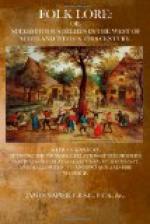There were numerous cures for hooping-cough of a superstitious character, practised extensively during the earlier years of this century, and some are still recommended. The following are a few of these. Pass the patient three times under the belly, and three times over the back of a donkey. Split a sapling or a branch of the ash tree, and hold the split open while the patient is passed three times through the opening. Find a man riding on a piebald horse, and ask him what should be given as a medicine, and whatever he prescribes will prove a certain cure. “I recollect,” says Jamieson, “a friend of mine that rode a piebald horse, that he used to be pursued by people running after him bawling,—
“Man wi’ the piety horse,
What’s gude for the
kink host?”
He said he always told them to give the bairn plenty of sugar candy. Put a piece of red flannel round the neck of a child, and it will ward off the hooping cough. The virtue lay not in the flannel, but in the red colour. Red was a colour symbolical of triumph and victory over all enemies. Find a hairy caterpillar, put it into a bag, and hang it round the neck of the child. This will prove a cure. Take some of the child’s hair and put it between slices of bread and butter, and give it to a dog; if in eating it, the dog cough, the child will be cured, and the hooping cough transferred to the dog. A very common practice at the present day is to take the patient into a place where there is a tainted atmosphere, such as a byre or a stable, a gas work, or chemical work. I have seen the gas blown on the child’s face, so that it might breath some of it, and be set a coughing. If during the process the child take a kink, it is a good sign. This idea must, I think, be of modern origin.
It was believed that if a present were given, especially if it were given to a sweetheart, and then asked back again, the giver would have a stye on the eye. Again, a stye on the eye was removable by rubbing it with a wedding ring. I suspect these two superstitions are portions of an ancient allegory, which, in time loosing their figurative meanings, came to be treated as literal facts.
Warts, especially when they are upon exposed parts of the body, are sometimes a source of annoyance to their possessors, and various and curious methods were taken for their removal. From their position on the body they also were regarded as prognostications of good or bad luck. To have warts on the right hand foreboded riches; a wart on the face indicated troubles of various kinds.
We have already noticed the cure recommended by the learned Sir Francis Bacon. The following are a few of the cures which were believed in within this century. Rub the wart with a piece of stolen bacon. Rub the wart with a black snail, and lay the snail upon a hedge or dyke. As the animal decays so will the wart. Wash the wart with sow’s blood for three days in succession.




